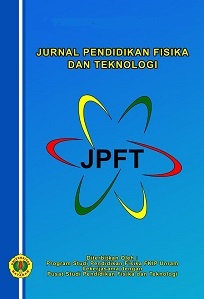Analysis of Teacher Difficulties in Teaching Physics Courses in MAN 1 Konawe Selatan
DOI:
10.29303/jpft.v8i2.3843Published:
2022-12-05Issue:
Vol. 8 No. 2 (2022): July-DecemberKeywords:
Physics Learning, Teaching Difficulties, MAN 1 Konawe SelatanArticles
Downloads
How to Cite
Downloads
Metrics
Abstract
This research was conducted with the aim of knowing the process of implementing physics learning, what factors cause teacher teaching difficulties and solutions to the teacher's difficulties. This research was conducted at MAN 1 Konsel with 3 physics teachers as informants who used descriptive methods through a qualitative approach. Data collection techniques with observation, interviews and documentation. The data analysis technique uses data collection, data reduction, presentation, and drawing conclusions or verification. From the results of the study, it was found that at the time of implementation of learning, it was found that all teachers had quite a difficulty in developing teaching materials. There are 4 factors that influence the difficulty of teachers in teaching physics, namely the low basic mathematical ability of students, inadequate facilities and infrastructure, the learning methods used by schools are less varied and innovative, and the time allocation is still lacking in achieving learning objectives. So the solution to answer the difficulties they are experiencing is that the teacher must involve students with good mathematical abilities to help their friends, using simple laboratory tools that the teacher can make themselves by using used materials or by using virtual laboratories, the teacher must also combine various methods and techniques. Innovative learning model, strives to maximize the available time allocation.
References
Diannisa, R., Karnati, N., & Supadi, S. (2022). Implementasi Manajemen Berbasis Sekolah (MBS) Di SD SPK New Zealand School. Hikmah: Journal of Islamic Studies, 17(2). DOI: https://doi.org/10.47466/hikmah.v17i2.182
Erlinda, N. (2016). Penerapan Metode Pembelajaran Inkuiri Disertai Handout: Dampak Terhadap Hasil Belajar Fisika Siswa SMAN 1 Batang Anai Padang Pariaman. Jurnal Ilmiah Pendidikan Fisika Al-Biruni, 5(2). DOI: https://doi.org/10.24042/jpifalbiruni.v5i2.122
Geyer, M.-A., & Kuske-Janben, W. (2019). Mathematical Representations in Physics Lessons. In Mathematics in Physics Education. DOI: https://doi.org/10.1007/978-3-030-04627-9_4
Gkioka, O. (2019). Pre-service physics teachers’ difficulties in evaluating experimental evidence. Egitim ve Bilim, 44(199). DOI: https://doi.org/10.15390/EB.2019.8030
Hestenes, D. (2017). The Genesis of Geometric Algebra: A Personal Retrospective. Advances in Applied Clifford Algebras, 27(1). DOI: https://doi.org/10.1007/s00006-016-0664-z
Kaya, D., & Keşan, C. (2016). The Effect of Time on Difficulty of Learning (The Case of Problem Solving with Natural Numbers). Malaysian Online Journal of Educational Sciences, 5(1).
Lin, T. J., Tan, A. L., & Tsai, C. C. (2013). A Cross-Cultural Comparison of Singaporean and Taiwanese Eighth Graders’ Science Learning Self-Efficacy from a Multi-Dimensional Perspective. International Journal of Science Education, 35(7). DOI: https://doi.org/10.1080/09500693.2013.776193
Lorenza, Y., Sasmita, P. R., & Amalia, S. (2019). Pengaruh Model Pembelajaran Inkuiri Terbimbing Berbantukan Alat Peraga Sederhana Terhadap Hasil Belajar Fisika Peserta Didik. Silampari Jurnal Pendidikan Ilmu Fisika, 1(2). DOI: https://doi.org/10.31540/sjpif.v1i2.761
Marsha R. Valencia. (2020). Modular Approach in Teaching Science 10. International Journal of Trend in Scientific Research and Development, 4(3).
Munawaroh. (2017). The Influence of Teaching Methods and Learning Environment to the Student’s Learning Achievement of Craft and Entrepreneurship Subjects at Vocational High School. International Journal of Environmental and Science Education, 12(4).
Pospiech, G., Eylon, B., Bagno, E., Lehavi, Y., & Geyer, M. A. (2015). The role of mathematics for physics teaching and understanding. Nuovo Cimento Della Societa Italiana Di Fisica C, 38(3). 15110-6
Rahmad, I. S., & Darmansyah. (2021). The Analysis of Teachers’ Difficulties in Teaching Mathematics at SMAN 2 Tambang. Journal of Research on Mathematics Instruction (JRMI), 2(1). DOI: https://doi.org/10.33578/jrmi.v2i1.41
Retnawati, H., Arlinwibowo, J., Wulandari, N. F., & Pradani, R. G. (2018). Teachers’ difficulties and strategies in physics teaching and learning that applying mathematics. Journal of Baltic Science Education, 17(1). DOI: https://doi.org/10.33225/jbse/18.17.120
Sugiyono. (2019). Metode Penelitian Pendidikan Pendekatan Kuantitaif, Kualitatif dan R&D. In Bandung: CV Alfabeta.
Winda, R., & Dafit, F. (2021). Analisis Kesulitan Guru dalam Penggunaan Media Pembelajaran Online di Sekolah Dasar. Jurnal Pedagogi Dan Pembelajaran, 4(2). DOI: https://doi.org/10.23887/jp2.v4i2.38941
Yuliati, I. (2021). Kemampuan Pemecahan Masalah Matematika Ditinjau Dari Minat Belajar Peserta Didik. Jurnal Cendekia : Jurnal Pendidikan Matematika, 5(2). DOI: https://doi.org/10.31004/cendekia.v5i2.547
Author Biographies
Halmuniati Halmuniati, IAIN Kendari
Muhammad Dani Saputra, IAIN Kendari
Nurfaidah Syam, Universitas Lakidende
La Wui, SMKN 1 Mananggu
License
Copyright (c) 2022 Halmuniati Halmuniati, Muhammad Dani Saputra, Nurfaidah Syam, La Wui

This work is licensed under a Creative Commons Attribution-ShareAlike 4.0 International License.
Authors who publish with Jurnal Pendidikan Fisika dan Teknologi (JPFT) agree to the following terms:
- Authors retain copyright and grant the journal right of first publication with the work simultaneously licensed under a Creative Commons Attribution License 4.0 International License (CC-BY-SA License). This license allows authors to use all articles, data sets, graphics, and appendices in data mining applications, search engines, web sites, blogs, and other platforms by providing an appropriate reference. The journal allows the author(s) to hold the copyright without restrictions and will retain publishing rights without restrictions.
- Authors are able to enter into separate, additional contractual arrangements for the non-exclusive distribution of the journal's published version of the work (e.g., post it to an institutional repository or publish it in a book), with an acknowledgement of its initial publication in Jurnal Pendidikan Fisika dan Teknologi (JPFT).
- Authors are permitted and encouraged to post their work online (e.g., in institutional repositories or on their website) prior to and during the submission process, as it can lead to productive exchanges, as well as earlier and greater citation of published work (See The Effect of Open Access).











